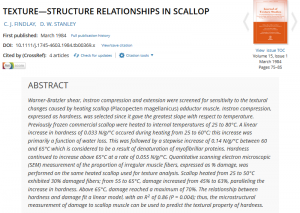Texture-structure relationships in scallop
 Warner-Bratzler shear, Instron compression and extension were screened for sensitivity to the textural changes caused by heating scallop (Placopecten magellanicus) adductor muscle. Instron compression, expressed as hardness, was selected since it gave the greatest slope with respect to temperature. Previously frozen commercial scallop were heated to internal temperatures of 25 to 80 ºC. A linear increase in hardness of 0.033 N/g/ºC between 60 and 65 ºC which is considered to be a result of denaturation of myofibrillar proteins.
Warner-Bratzler shear, Instron compression and extension were screened for sensitivity to the textural changes caused by heating scallop (Placopecten magellanicus) adductor muscle. Instron compression, expressed as hardness, was selected since it gave the greatest slope with respect to temperature. Previously frozen commercial scallop were heated to internal temperatures of 25 to 80 ºC. A linear increase in hardness of 0.033 N/g/ºC between 60 and 65 ºC which is considered to be a result of denaturation of myofibrillar proteins.
Hardness continued to increase above 65 ºC at a rate of 0.055 N/g/ ºC. Quantitative scanning electron microscopic (SEM) measurement of the proportion of irregular muscle fibers, expressed as a % damage, was performed on the same heated scallop used for texture analysis. Scallop heated from 25 to 50 ºC exhibited 30% damaged fibers; from 55 to 65 ºC, damage increased from 45% to 63%, paralleling the increase in hardness. Above 65 ºC, damage reached a maximum of 70%. The relationship between hardness and damage fit a linear model, with an R2 of 0.86 (P=0.004); thus, the microstructural measurement of damage to scallop muscle can be used to predict the textural property of hardness.
![]()
Findlay, C. J., & Stanley, D. W. (1984). Texture structure relationships in scallop. Journal of Texture Studies, 15(1), 75-85. http://dx.doi.org/10.1111/j.1745-4603.1984.tb00369.x